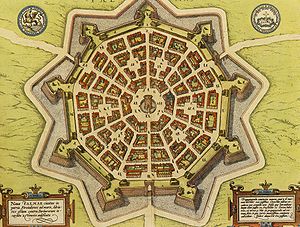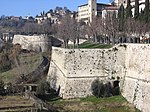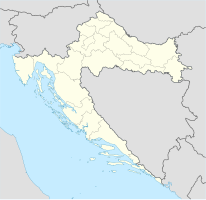Venetian defense system from the 16th to 17th centuries
| Venetian defense system of the 16th to 17th centuries: Stato da Terra - western Stato da Mar | |
|---|---|
|
UNESCO world heritage |
|

|
|
| Palmanova as an ideal city in star shape |
|
| National territory: |
|
| Type: | Culture |
| Criteria : | (iii), (iv) |
| Surface: | 378.37 ha |
| Buffer zone: | 1749.62 ha |
| Reference No .: | 1533 |
| UNESCO region : | Europe and North America |
| History of enrollment | |
| Enrollment: | 2017 ( session 41 ) |
Venetian defense system from the 16th to the 17th century is one of the UNESCO -listed site of world cultural heritage . The transnational world heritage site includes six defensive structures and fortresses in Italy , Croatia and Montenegro .
background
The fortifications bear witness to the Republic of Venice , which played the role of a maritime and economic power in the Mediterranean for several centuries . Various fortifications were built to protect the ruled area. The defensive structures of the Stato da Terra protected the republic from other European powers in the north-west. Those of the Stato da Mar protected the Adriatic ports and the trade routes into the Levant . They were necessary to ensure the expansion and authority of the Republic of Venice. The invention of gunpowder led to significant changes in military technology and architecture, which can be seen in the bastions in the so-called "alla moderna" style.
registration
Venetian defense structures from the 16th to 17th centuries were entered on the UNESCO World Heritage List in 2017 based on a resolution of the 41st session of the World Heritage Committee. The entry was made on the basis of criteria (iii) and (iv).
Single sites
The Venetian defense system of the 16th to 17th centuries is a serial (consisting of several separate components), transnational (spanning several states) World Heritage Site. The six individual sites are spread over a distance of more than 1000 kilometers - from Lombardy to the Montenegrin coast . They have a total protected area of about 378 hectares , of which around 90 percent are in Italy. The individual protection areas are each surrounded by buffer zones, which have a total area of 1749 ha.
cards
|
|
|
list
| Ref.No. 1533- |
image | Surname | Place, region, country | Protection area | Buffer zone |
|---|---|---|---|---|---|
| 001 |

|
The fortified city of Bergamo
( Location ) |
Bergamo , Lombardy , Italy |
119.61 ha | 446.07 ha |
| 002 |

|
The fortified city of Peschiera del Garda
( Location ) |
Peschiera del Garda , Veneto , Italy |
36.67 hectares | 143.85 ha |
| 003 | Fortified city of Palmanova
( Location ) |
Palmanova , Friuli Venezia Giulia , Italy |
193.73 hectares | 296.27 hectares | |
| 004 |

|
Zadar Defense System
( Location ) |
Zadar , Zadar County , Croatia |
11.19 hectares | 240.45 hectares |
| 005 |

|
St. Nicholas fortress in Šibenik
( Location ) |
Šibenik , Šibenik-Knin County , Croatia |
0.85 ha | 523.79 hectares |
| 006 |

|
The fortified city of Kotor
( Location ) |
Kotor , Montenegro |
16.32 hectares | 99.19 ha |
Sites not considered
In addition to the individual sites listed above, other sites had been proposed but were not included in the world heritage. These include:
- in Croatia Šibenik , Hvar and Korčula and
- in Montenegro Herceg Novi and Ulcinj .
From Italy, the proposal still contained the defense system of the Venice lagoon in Venice and Chioggia with the arsenal , the Fort Sant'Andrea , the octagonal fortresses and the Fort San Felice . These were also not considered as components of the "Venetian Defense System of the 16th to 17th Century". “Venice and its lagoon”, however, has been registered on the World Heritage List as a separate cultural heritage site since 1987.
Others
A similar transnational serial nomination as for the Venetian Defense System is sought for trading posts and fortresses in the Genoese colonies between the Mediterranean and the Black Sea . Proposals have been received from Ukraine since 2010 and from Turkey since 2013.
Web links
Individual evidence
- ↑ Official name English Venetian Works of Defense between the 16th and 17th Centuries: Stato da Terra - Western Stato da Mar , French Ouvrages de défense vénitiens du XVIe au XVIIe siècle: Stato da Terra - Stato da Mar occidental , German translation according to the World Heritage List. In: Unesco.de. Retrieved March 16, 2018 .
- ↑ a b c d Venetian Works of Defense between the 16th and 17th Centuries: Stato da Terra - Western Stato da Mar. In: whc.unesco.org. UNESCO World Heritage Center, accessed March 16, 2018 .
- ↑ Decision: 41 COM 8B.21. In: whc.unesco.org. UNESCO World Heritage Center, accessed March 16, 2018 .
- ^ Venetian Works of Defense between the 16th and 17th Centuries: Stato da Terra - Western Stato da Mar. Maps. In: whc.unesco.org. UNESCO World Heritage Center, accessed March 16, 2018 .




